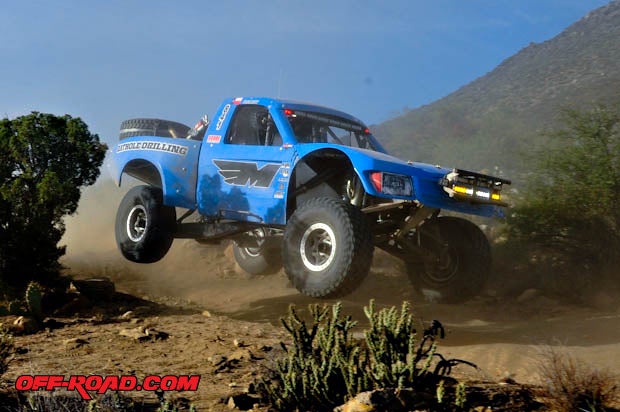
Many have said that the famed SCORE Baja 1000 is a war. A war against your competitors, a war against yourself and a war against Baja itself. Finishing each section of the course is a smaller battle with ups and downs like boulders, silt beds, ravines and water hazards. Each battle wears on the driver, the team and the equipment. If your training, preparation and luck are up to snuff you may be lucky enough to finish the race and win the war against Baja. Logistically, a peninsula run like this year's 1000 is much like an army on the move. The teams must ensure that supply lines are open to get fresh drivers, fuel, parts and anything else needed to the race car at any point along the 1275-mile course. It involves massive land movements of chase trucks, people and even air support.
Mills Motorsports is well prepared to fight the war against Baja, and the team uses military planning, experience and strategies to do it. The team is comprised of former and active duty Military, Law Enforcement and Firefighters along with a handful of civilians. Many come from the cream of the crop of elite units. Veterans of Police SWAT teams, Navy SEALS, Green Berets and Army Special Operations units are common among the Mills crew.
Mills Motorsports, a team from Corpus Christi, Texas, is unique not because of its size, but rather its makeup and management style. The two-truck team races in both Class 8 and Spec Trophy Truck and is made up of just 30 members. It's not a tiny team but it is much smaller than many two-car teams that race in the SCORE series.
What really sets the team apart, though, is that it is run like an actual military unit. Their leader, a US Marine Pilot, Kent Kroeker is the Commanding Officer. Kroeker's uncle used to race a Honda ACE 100, and Kent was fascinated with stories of the races, like Barstow to Vegas, and how the rider first had to beat the desert before beating the other riders. Kroeker and his brother washed cars all summer to buy an XR75 that they spent many hours on in the dirt. Later Kroeker found his way into motocross and D37 races over the years, until in 1998 he found himself racing the Baja 1000 when he finished mid pack in Class 30.
Kroeker learned a lot in the years he spent with the US Marines and he brings that to the Mills Motorsports team. The day-to-day routines are similar to life in the military. Whether at the race shop or down in Baja prerunning, the day always begins with the team up at 5 in the morning. They do breakfast at 6 a.m., physical training starts at 7 a.m. followed by a team meeting at 8 a.m. After the meeting the workday begins. Kroeker ensures that physical fitness is an integral part of their daily routine for many reasons.
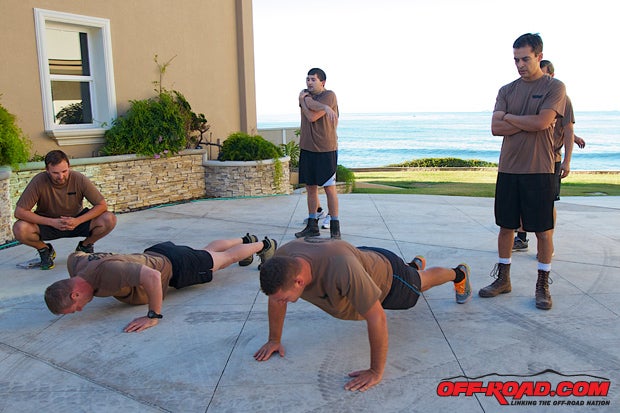
"We need to be fit for off-road racing – and not just drivers and navigators. Keeping your mental acuity during long hours of sleep deprivation, the ability to lift 150-lb. tires and move 70-lb. jacks around isn't for the weak. Training together bonds us as a team. We encourage those who are weaker and follow those who are stronger. As group fitness increases, the number of errors goes down. Fitness makes us more efficient. "
Kroeker is no stranger to controversial statements and finished with this thought: "Additionally, I've always disliked the fact that off-road racing is considered a ‘sport’ when 90% of the people who participate in it – drivers included – don't look like they are fit enough to play an afternoon of croquet. This is not to say that everyone on our team looks like friggin' Charles Atlas, but those who don't are working on it!"
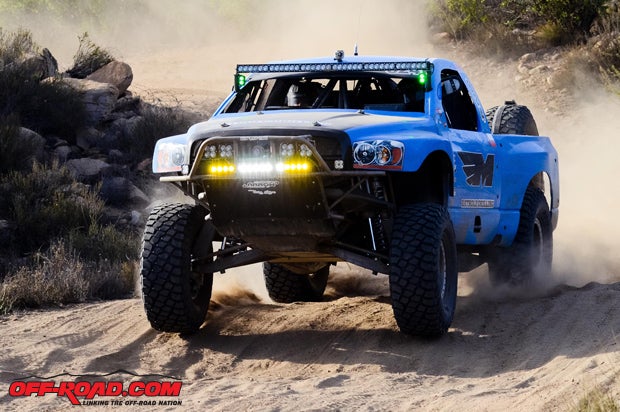
Like many successful race team managers Kroeker believes in preparation and sweat equity, but he breaks into down into its basic components.
"One thing I won't tolerate is the typical ‘thrash,’” he said. “A thrash is when you haven't done your planning properly prior to the race and your time management sucks – so you end up working late, then starting late the next day. People get tired, eat comfort food, get off their circadian rhythms. This creates a cycle of inefficiency that carries through race day. People show up to the race tired, stressed out and overworked. Humans are organisms – little machines – and they require regular feeding, rest and maintenance. A race organization is the same but has more moving parts. Keep it on the same cycles and it will perform. And that's the thing with off-road racing – like aviation, especially military aviation in combat – the slightest little human error will cause failure. Keep the humans in good condition and the mission will succeed. Simple formula.
"The other thing I believe about desert racing is that winning – especially championships – is a byproduct of hard work and intense preparation, not taking giant risks and having good luck. We work harder, test more, and are more intellectually devoted to the mission than any team out there; this is not a hobby for any of us."
Taylor Mills, the primary driver of the team and he himself a civilian, spoke about the transition to Kroeker's military structure. "I think it's awesome,” Mills said. “When we got with Kent and doing the PT, everyone on the team just started training harder, it influenced the whole team to better themselves. It was culture shock for a lot of the people, we had smokers and people who hadn't worked out in years, but it became a common ground that we all had to adapt to, to stay on the team and be respected by the members of the team."
For Kroeker, going from the military to racing was a seamless transition, and that is mentality that he helped transfer to the entire team.
"Baja racing – especially point to point - is exactly like maneuver warfare,” Kroeker said. “Desert racing is less complex than ground combat, but the principles are identical. Replace ‘enemy’ with ‘competitors’ and ‘the desert’ and you go from war to race. Both war and racing are extremely dynamic – lots of movement is taking place, much of it simultaneously. To be good at mission planning takes four-dimensional thinking that I learned from being part of the MAGTF (Marine Air Ground Task Force). I jokingly call my current unit a MAGTF but it's ‘Mills’ instead of ‘Marine.’ We have all the same stuff – an air element (the helo), a maneuver element (the race truck), the support element (chase) and a mission.
“The biggest takeaway for me from the Marines wasn't the operational and logistics piece; the biggest takeaway was the leadership piece. The Marine Corps has leadership broken down to a science – and these traits and principles are imbued in us from day one – both officers and enlisted. Leadership is a never-ending, lifelong pursuit, and I've brought that process to our team. Everyone on my team speaks the language of leadership – even the non-military guys. Ask anyone what the 14 Marine Corps leadership traits are and they will tell you – everyone has them memorized. Throw them a bent, broken, hopeless race truck and they will find a way to get it to the finish line. They are animals that will to do more work, be more proactive, take more initiative and work together more cohesively than any other race team out there, because they're all leaders."
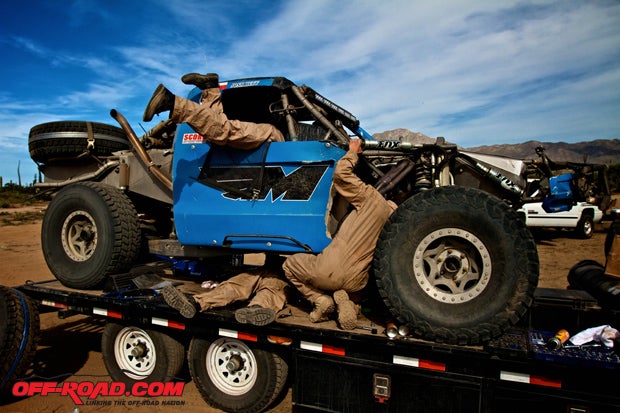
Many teams at the top level of desert racing have close to 100 people on the team for a peninsula run, but not Kroeker. He patterns his team, which consisted of a total of 30 people, like an Army Operational Detachment Alpha (ODA) team. An ODA, or Special Forces A Team as they are more commonly known, is made up of just 12 people, yet they can accomplish the same missions as a much larger force. Each member of an A Team in an expert in their field: weapons, communications, engineering and demolition and medics, to name a few. Additionally each member is cross-trained in the other skill sets of the team.
On the Mills team the specialists consist of mechanics, fabricators, logistics planners and medics. " We only use 30 dudes to support a peninsula run, but each guy has a specific field of expertise,” Kroeker says. “And we have zero mouth-breathers – like the preponderance of ‘volunteers’ on many teams. We have 30 guys that are all top-level Baja Operators. I have handpicked every single one of them and trained them all. They are a different level of performer. I put together chase crews that are a mix of strengths, weaknesses and skill sets so that each crew has a mission set that they can perform that is above and beyond what 20 or 30 regular guys can do, with just a three-man crew in a chase truck.
“That is what I have been working on for the last few years, training guys to perform in that manner and at that level. The planning and training is exhausting, but managing 30 competent, motivated, committed dudes who perform exactly as they were trained is way less frustrating than handling 100 or even 1000 marginal foot-shufflers who think the mission ends when their personal comfort is compromised."
Discipline is a key component of the team as well. There is no drinking (alcohol) while in country before the race, and few drink coffee or energy drinks either. “We don't use energy drinks, coffee or stimulants the way many other teams do; we believe in physical fitness and staying focused,” Kroeker says. “If you've been up for 30 hours and are taking energy drinks, you won't get any useful rest when you have a five-hour window while waiting for the truck. It's just like running a combat mission. There are no energy drinks out in the field in the military, and they don't work long term; it's just a short burst until you hit the wall and become ineffective."
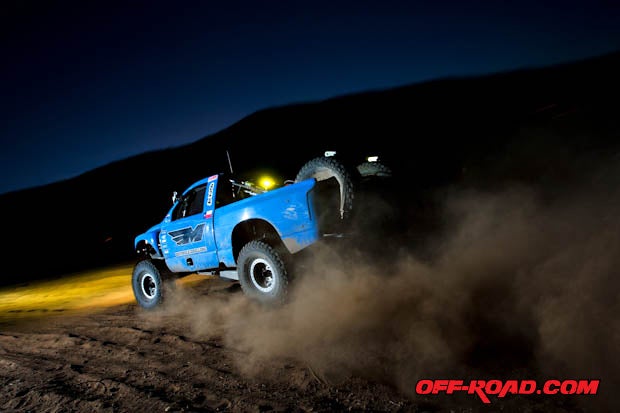
While Kroeker and team stick to a rigid schedule and "battle plan" they are also innovators. A good example is the V10 engine they have been developing. They raced the engine in Class 8 this season and will run it in Trophy Truck in 2015. The work started in 2011, and the team has over 1 million dollars invested into the engine program to date.
“Today's small block, stroker Trophy Truck motors make about 800 horsepower over a very narrow RPM range, have short piston skirts, high-lift cams and a lot of spring tension,” Kroeker explains. “They displace upwards of 450 cubic inches and are fortunate to last 1500 miles without a total rebuild. Now enter 20% more cylinders in a lightweight, all aluminum 500-lb. package that makes over 900 HP and has a perfectly linear power band. Pistons are conventional, reciprocating parts are smaller and lighter, valve spring tension is lighter, yet it displaces 512 cubic inches! Our SRT-10 Dodge Class 8 that just won the Baja 1000 does 145 mph – that motor is still like new and has 4300 race miles on it. Because of our development effort, that solved air and fuel filtration, and ignition problems and an solid partnership with Lee Carducci (the designer of the Gen 4 Viper Motors) of Arrow Racing Engines, we expect this package to change the way Trophy Trucks are powered. Imagine racing a 900-horsepower engine for three seasons without a rebuild. This kind of performance and reliability is unheard of in off-road racing."
The engine was named the 512 Gustav, after the Schwerer Gustav. It was the largest artillery piece ever made, and it was mounted to a railroad car. With a bore diameter of 800 mm, or 31.5 inches, it fired 15000+-pound shell 29 miles. Even military history finds its way into the day-to-day life of the Mills Motorsports team.
Putting the Plan to Action in Baja
All of the discipline, training and planning contribute to the team's race plan. A 60-page document details each movement and action of the team along with addressing a myriad of contingencies when things go wrong in Baja, as they often do. If the Spec Trophy Truck finished the race they would win the Championship and a Toyota Milestone Award for completing every mile of every race that year.
Part of that planning for disaster includes spare parts. In the Mills case, spare parts for spare parts. For the Spec Trophy Truck the team had five spare transmissions, multiple steering racks, lower control arms, upper arms, tie rods, track rods, trailing arms, and even tabs to weld it all back together. In addition, the race truck being loaded with alternators, steering pumps and other easy-to-swap, in-the-field spares.
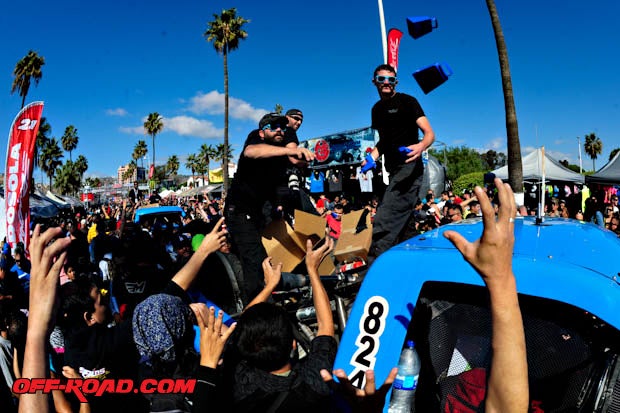
The planning and preparation was put to use by the Mills team before the race even started. Taylor Mills’ prerunner went off a washed-out bridge North of Loreto at 60 mph and landed on its roof. Just a few feet short of a 15-foot deep waterhole. Mike Meeks, in the other prerunner, also found a washed-out section of the course near race mile 1100 and barrel-rolled eight times. In both cases the teams were able to get the trucks wheels down and running again with knowledge, ingenuity and a bit of help from their fellow competitors.
Race day itself was a mix of highs and lows. The plan was for the Class 8 to follow the Spec Trophy Truck (which started first) all the way down the peninsula to La Paz and render assistance when needed, like being stuck in a silt bed. It was part of the plan to get the spec truck to the finish and claim the Championship.
In Baja, as in war, a battle plan often only survives first contact with the enemy. Darren Skilton, a wily and successful veteran of Baja and many other races, started the race in the Spec Trophy Truck. At Valle de Trinidad, near race mile 125, disaster struck. Skilton got tangled up with another Spec Trophy Truck and crashed end over end at close to 100 mph. Skilton was injured in the crash but has since recovered. The crash also nearly totaled the truck – it even ripped off a corner! This presented a unique problem for the team, as the majority of chasers and spares were on the Pacific coast at San Vicente or farther south. Kroeker summarized the issues as such: "It was worst thing at the worst place, at the worst time of the race that could ever happen."
The limited crew in the area started doing what repairs they could while a chase crew with the required tools and spares started a four-hour trip from San Vicente up to and through Ensenada, and then out Highway 3 to get to the truck at Valley T.
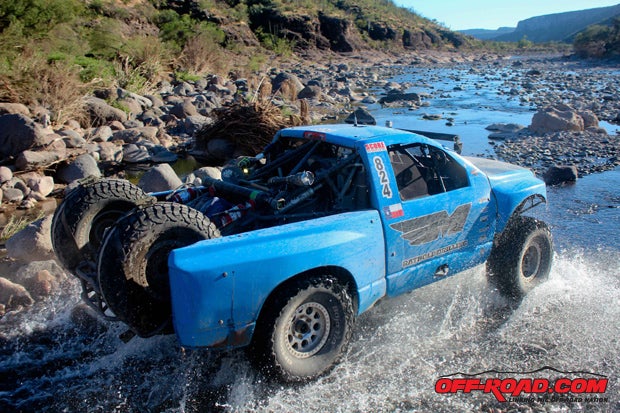
While all this was happening the Class 8 truck was trouble free. It made no sense for the Class 8 to wait around for the Spec Trophy Truck. The Class 8 continued on down the peninsula with drivers Alan Roach of Baja Designs lighting and Mike Meeks. The Class 8 ended up having a flawless day, no issues, flats or stucks and the team won their class and the Class 8 Championship, and they finished 13 hours ahead of the spec truck.
After the spec truck was repaired, Kroeker himself took over for Skilton. The team planned to do a driver swap in El Arco at race mile 620, where Taylor Mills would get in and race to the finish. That plan had issues as well. After all the repairs from the initial crash, the team suffered a transmission failure and had to change it out at El Crucero near race mile 472. That led to even more downtime and would make finishing the race within the 49-hour time limit a much harder task.
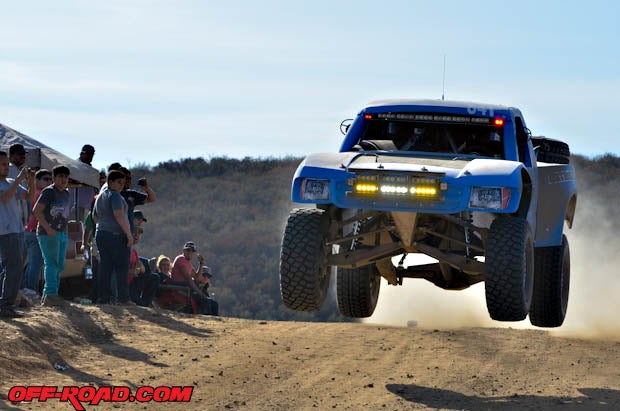
Eventually Taylor Mills took over driving duties and managed to get the truck to the finish in La Paz in fourth place. At 46 hours 29 minutes and 04 seconds, the truck took the checkered flag with less than two hours left before timing out. The finish secured their second SCORE Championship of the day and made Taylor Mills just 1 of 12 racers to complete all 2,315.8 miles of the 2014 season, which earned him a Milestone Award on top of it all.
Kroeker spoke about the perseverance and dedication of his team after the race. "They do whatever it takes,” he said. “This was a classic Baja story and a testament to how good this team is and how much we care."
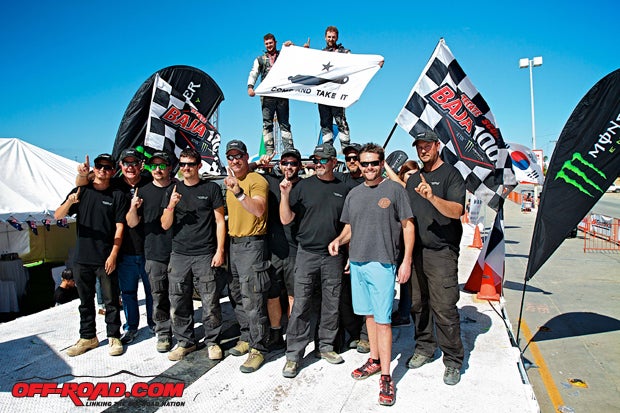
While serious on race day, the team also makes time to have a lot of fun – sometimes at the expense of others. During contingency for the 2014 Baja 500, one of the team members put a sticker over the helmet visor of Trophy Truck racer and masked man Robert Acer. Acer was obviously not happy with the rogue stickering and video of the incident spread like wildfire over the Internet.
"That brought us a lot of attention, some of it probably negative,” Kroeker said. “We did not mean any harm by it; we were just having fun. It did give character to our team and it's what we are about. We are a little mischievous; we like poking the bear. We have a lot of love for each other, and we are a tight close knit group, but we don't take ourselves too seriously."
Kroeker routinely "pokes the bear" with fellow racers on the Internet, but there is a good reason for his actions. "When I see people taking themselves too seriously on the Internet, and getting their panties in a wad, I like to take advantage of that, because there is no reason for it. This is desert racing. If you can't have fun and laugh at stuff, you just need to f*%king go kill yourself, and you can quote me on that. It will stop being fun if we all take ourselves too seriously."
You can see Kent Kroeker, Taylor Mills and the rest of the Mills Motorsports team next at the San Felipe 250 in January where they will be debuting their 512 Gustav engine in a Trophy Truck.


 Your Privacy Choices
Your Privacy Choices